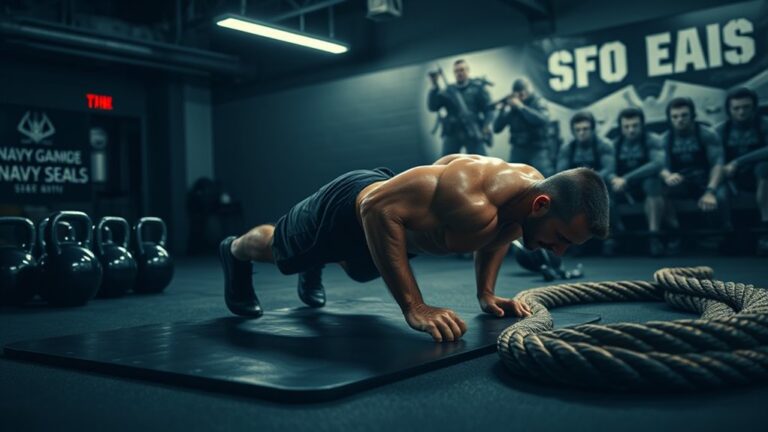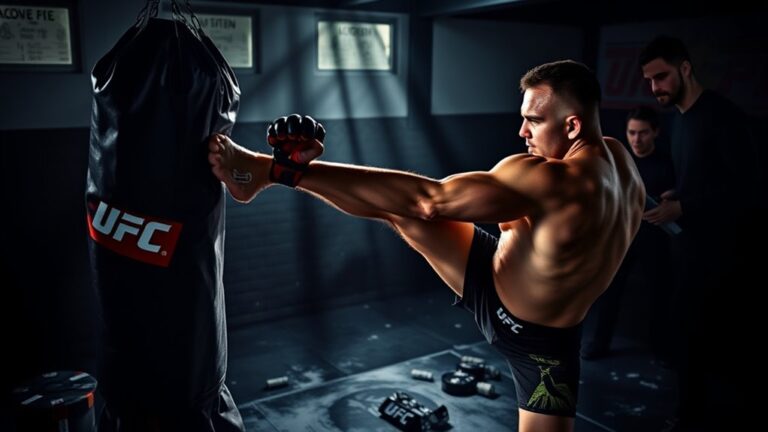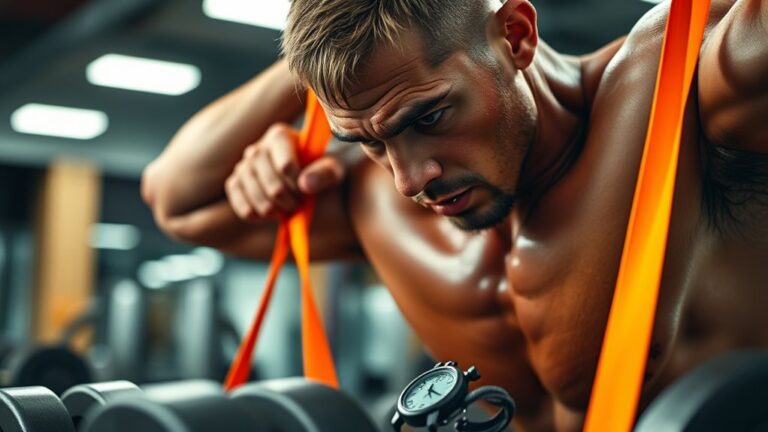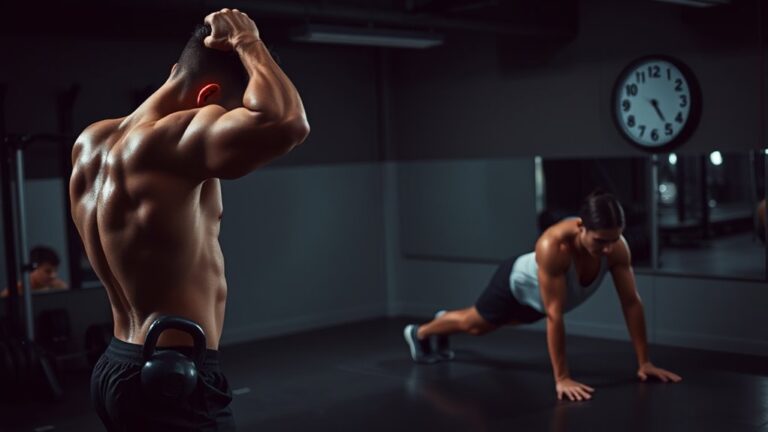Deadlifts vs. Squats: Which One Is More Effective?
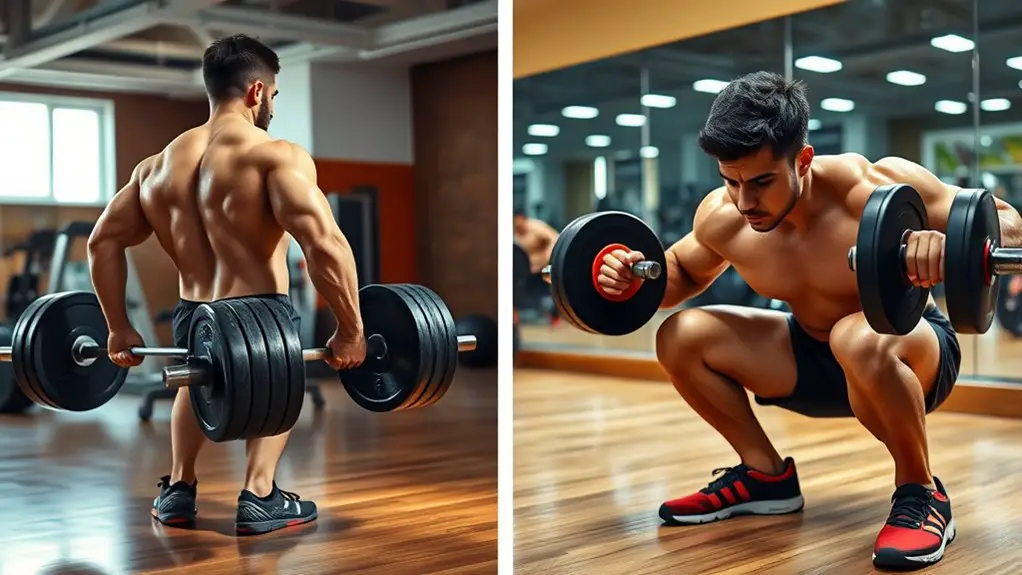
When deciding between deadlifts and squats, it really depends on your fitness goals. Deadlifts focus on the posterior chain, enhancing overall body strength, while squats target your legs and core. Both exercises promote strength and muscle growth but emphasize different muscle groups. You might find that alternating between them delivers the best results. Want to know more about their unique benefits and how to incorporate them into your routine? There’s plenty to explore!
Understanding the Mechanics of Deadlifts
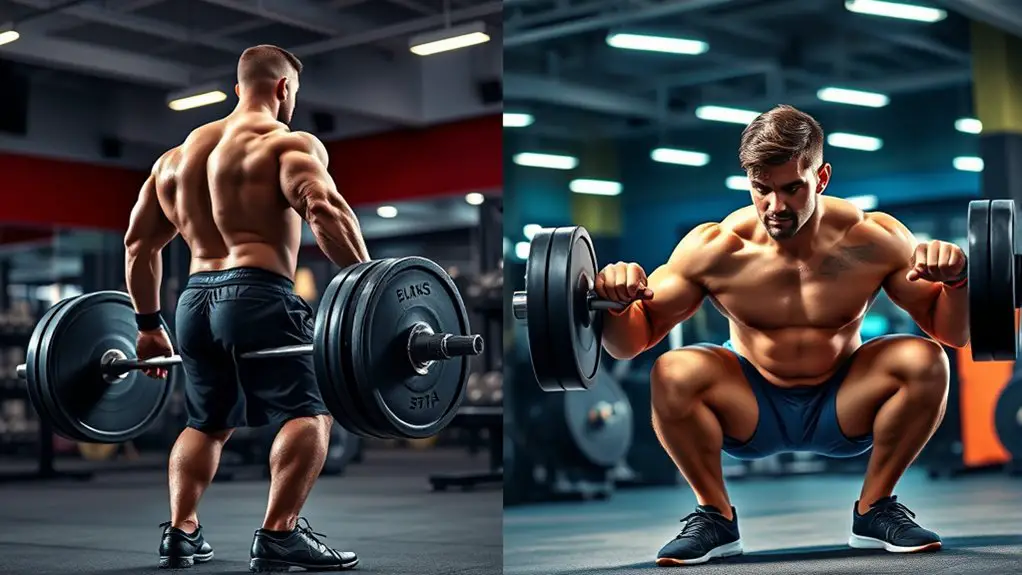
When you think about deadlifts, it’s vital to grasp the mechanics behind the movement to maximize your performance and minimize injury risk. Understanding how to position your body can lead to effective deadlift variations, such as sumo or Romanian deadlifts. Each variation targets different muscle groups and helps in developing overall strength.
Focusing on your form is essential. Keep your back straight, engage your core, and make sure your feet are shoulder-width apart. This alignment not only enhances your lifting power but also protects your spine from undue stress.
Incorporating deadlifts into your routine offers numerous benefits, including improved posture and increased muscle mass. As you build strength, you’ll notice improvements in other lifts and daily activities. By paying attention to these mechanics, you’ll reveal the full potential of your deadlift journey while prioritizing your safety and well-being.
Understanding the Mechanics of Squats
When you think about squats, it’s vital to understand the muscle groups they’re targeting. Proper form is essential to maximize your gains and prevent injury. Let’s break down how to execute this foundational move effectively.
Muscle Groups Targeted
Squats are a powerhouse exercise that targets multiple muscle groups, making them an essential part of any strength training routine. They primarily engage:
- Your quadriceps for powerful leg strength
- Your glutes for a firmer backside
- Your core for stability and balance
Incorporating various exercise variations can enhance your workout, ensuring you’re not only preventing boredom but also maximizing results. When you focus on hypertrophy strategies, you can effectively build muscle and improve overall strength. Remember, prioritizing safety while performing squats is vital. Always listen to your body, maintain proper alignment, and avoid excessive weights, especially if you’re new to the exercise. This will help you achieve your fitness goals while minimizing the risk of injury.
Proper Form Essentials
To guarantee you’re reaping the full benefits of squats, mastering proper form is essential. Start with a proper grip—your feet should be shoulder-width apart, and your toes slightly pointed out. As you lower into the squat, engage your core and maintain a neutral spine to promote injury prevention. Pay attention to your breathing technique; inhale as you descend and exhale when pushing back up. This rhythm helps maintain stability. Consider incorporating workout variations, like goblet squats or sumo squats, to target different muscle groups while keeping your form intact. Remember, prioritizing safety and proper mechanics will enhance your performance and minimize the risk of injury, making your squat routine more effective and enjoyable.
Muscle Groups Targeted by Deadlifts
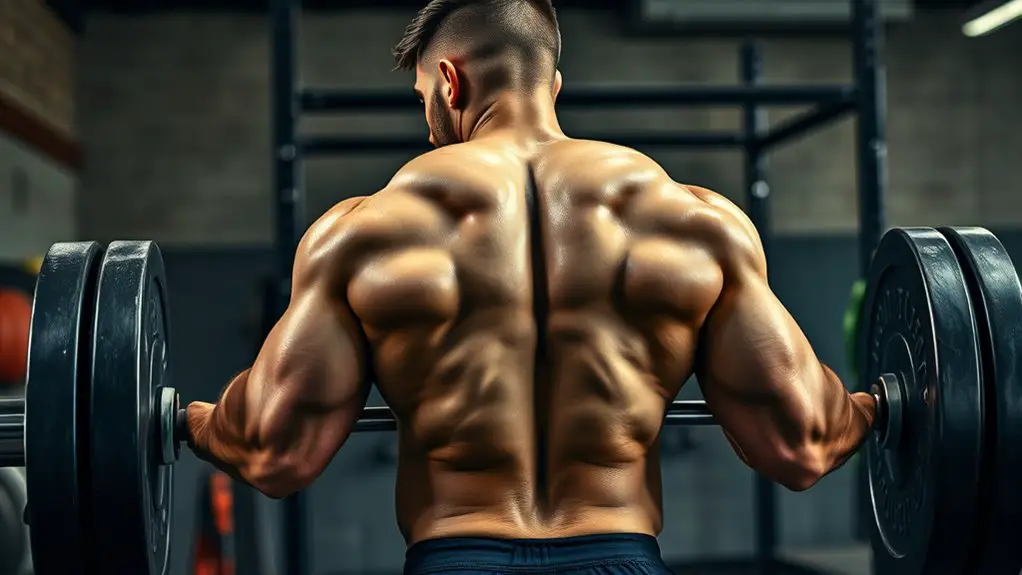
Deadlifts are a powerhouse exercise that targets multiple muscle groups, making them a favorite among strength trainers. They effectively engage your posterior chain, ensuring you build strength in a balanced way. Here’s what you can expect to work:
Deadlifts engage multiple muscle groups, making them essential for balanced strength training and effective posterior chain development.
- Hamstring engagement: Strengthening these muscles helps improve your overall power.
- Glute activation: This promotes better stability and posture.
- Core engagement: A strong core supports your lower back and enhances performance.
Additionally, deadlifts involve trapezius involvement, which aids in shoulder stability, and they boost your grip strength as you lift. You’ll also find that they counteract quad dominance by equally developing your lower back and hamstrings. When performed correctly, deadlifts can be incredibly safe and beneficial, ensuring you build strength effectively while minimizing injury risk. Just remember, proper form is key to reaping these rewards!
Muscle Groups Targeted by Squats
When it comes to strength training, squats are a fundamental exercise that engages a variety of muscle groups, making them crucial for building lower body strength. When you perform squats, you’re primarily targeting your quadriceps, hamstrings, and glutes. This multi-muscle engagement not only helps in muscle development but also enhances muscle endurance, allowing you to perform daily activities with ease.
Incorporating squat variations, like front squats or goblet squats, can further engage your core and improve balance. It’s important to maintain proper form to guarantee safety and avoid injury. Keeping your back straight, knees aligned with your toes, and lowering yourself to a comfortable depth can make a big difference. By varying your squat routine, you can keep your workouts interesting while maximizing the benefits for your lower body. So, whether you’re a beginner or an experienced lifter, squats are a crucial part of your strength training regimen.
Strength Gains: Deadlifts vs. Squats
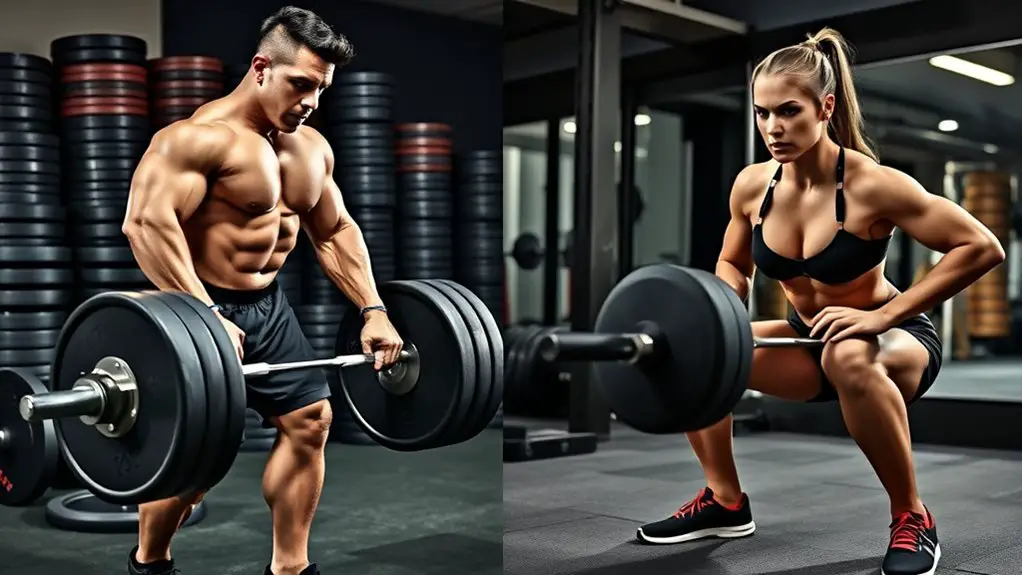
While both deadlifts and squats are essential for building strength, they target different muscle groups and offer unique benefits. When considering your strength progression, it’s important to understand how each exercise contributes to your goals and workout frequency.
Deadlifts are fantastic for overall body strength, focusing on your posterior chain, while squats emphasize your legs and core. Here’s what you can expect from each:
- Improved overall strength: Both exercises enhance your functional strength.
- Versatility in workouts: You can incorporate them into various training routines.
- Increased stability and balance: They help build a strong foundation for other lifts.
To maximize your results, think about alternating between both exercises. This balance will not only keep your workouts engaging but also promote safe, steady progress in your strength gains. Remember, safety first—always prioritize proper form!
Muscle Growth: Deadlifts vs. Squats
Although both deadlifts and squats play an essential role in muscle growth, they activate different muscle fibers and encourage distinct adaptations. Deadlifts primarily target your posterior chain, engaging muscles like your hamstrings and glutes, while squats focus more on your quadriceps. This means that if you’re aiming for muscle hypertrophy, incorporating both exercises into your routine can be beneficial.
However, it’s important to prioritize safety. Make sure you use proper form and start with manageable weights to prevent injuries. Additionally, don’t overlook recovery strategies. Adequate rest, hydration, and nutrition are crucial for muscle repair and growth. Balancing your workouts with these recovery techniques will help you maximize your gains while minimizing the risk of overtraining. By understanding how each exercise affects your muscles, you can tailor your training for best results, making certain you build strength safely and effectively.
Functional Benefits of Deadlifts and Squats
When you think about functional benefits, deadlifts and squats play a key role in enhancing core stability and activating different muscle groups. Each exercise targets your body in unique ways, which can improve your overall strength and performance in daily activities. Let’s explore how these movements contribute to your functional fitness.
Core Stability Enhancement
Core stability is crucial for overall strength and injury prevention, and both deadlifts and squats play a key role in enhancing this stability. By focusing on core engagement during these exercises, you’ll develop a stronger foundation for all your movements.
Consider these emotional benefits of improved core stability:
- Confidence in everyday activities: You’ll feel more secure in your movements, reducing the fear of injury.
- Enhanced athletic performance: A stable core helps you perform better in sports and physical activities.
- Better posture and alignment: Improved stability training leads to a more balanced body, reducing strain on your back.
Incorporating deadlifts and squats into your routine can greatly enhance your core stability, keeping you safe and effective during workouts.
Muscle Activation Differences
Improved core stability lays the groundwork for understanding how deadlifts and squats activate different muscle groups. When you perform a deadlift, you engage your posterior chain, including the hamstrings, glutes, and lower back. This activation pattern promotes overall strength and stability, which can enhance functional movements in daily life. On the other hand, squats primarily focus on the quadriceps, glutes, and core, fostering muscle engagement that supports your ability to rise from a seated position or lift objects. Both exercises offer unique benefits, but it’s crucial to prioritize proper form to prevent injury. By understanding these activation patterns, you can tailor your workout routine to meet your fitness goals while ensuring safety and effectiveness.
Frequently Asked Questions
Can Deadlifts and Squats Be Performed Safely at Home?
Yes, you can safely perform deadlifts and squats at home. It’s essential to focus on proper form to avoid injuries. Start with lighter weights or even just your body weight until you feel comfortable. Make sure you have enough space and a flat surface. Consider using a mirror or recording yourself to check your technique. With proper precautions, these exercises can be effective components of your home workout routine.
How Do Deadlifts and Squats Affect Athletic Performance?
Deadlifts and squats can greatly boost your athletic performance. They enhance explosive strength, which is essential for various sports. By incorporating these exercises into your routine, you’ll reap powerlifting benefits, improving your overall strength and stability. To stay safe, focus on proper form and start with lighter weights. Gradually increase resistance as you build confidence and strength. Always listen to your body to avoid injury and maximize your training effectiveness.
What Equipment Do I Need for Deadlifts and Squats?
If you’re ready to commence your strength journey, you’ll need some essential gear. A sturdy barbell, like an Olympic barbell, is your primary weapon, along with a variety of weight plates to challenge yourself safely. Make sure you’ve got a good lifting platform or mat to protect your floors and a pair of lifting shoes for stability. Remember, proper equipment not only enhances performance but also keeps you safe while you lift!
Are There Any Common Injuries Associated With Deadlifts or Squats?
When you’re lifting, it’s essential to be aware of common injuries, like strains or sprains, which can occur if you don’t focus on form. Injury prevention starts with understanding these risks and avoiding common mistakes, such as rounding your back or locking your knees. Always warm up properly and consider lighter weights to guarantee you’re performing each movement correctly. This way, you can enjoy your workouts while staying safe and injury-free.
How Often Should I Incorporate Deadlifts and Squats Into My Routine?
Incorporating deadlifts and squats into your routine is like balancing a scale; you need harmony for ideal results. For most people, aiming for two to three sessions of each per week is a solid guideline. This frequency allows you to build strength while minimizing the risk of injury. Make sure you alternate with rest days for recovery, creating a well-rounded workout balance that promotes safety and effectiveness in your fitness journey.

